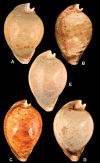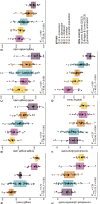A multivariate approach to morphological study of shell form in cowries (Gastropoda, Cypraeidae): a case study with Umbiliaarmeniaca (Verco, 1912)
- PMID: 37215693
- PMCID: PMC10193853
- DOI: 10.3897/zookeys.1158.98868
A multivariate approach to morphological study of shell form in cowries (Gastropoda, Cypraeidae): a case study with Umbiliaarmeniaca (Verco, 1912)
Abstract
Multivariate approaches to morphological study of shell form have rarely been applied to cowries (Gastropoda: Cypraeidae) with preference, instead, for comparing formulaic notations of shell form that report averages (i.e., means) for key morphometrics such as shell dimensions, their ratios, and counts of apertural teeth. Although widely applied, the "shell formula" does not account for variation among individuals or support statistical comparison between taxa. This study applied a multivariate approach to analyse shell form within the four accepted subspecies of the cowrie, Umbiliaarmeniaca (Verco, 1912) and included a previously unstudied, and most northerly, population of U.armeniaca from Lancelin, Western Australia. Multivariate analyses readily separated the recognised subspecies of U.armeniaca (U.a.armeniaca, U.a.diprotodon, U.a.clarksoni and U.a.andreyi), but did not separate the Lancelin population from U.a.andreyi, indicating that the former represents a northward extension of U.a.andreyi that is not morphometrically distinguishable. These results provide improved understanding of infraspecific differences in shell form of U.armeniaca across its broad distribution, and demonstrate the utility of multivariate morphometric methods for statistical comparison of shell form between taxa. This approach is complimentary to existing research practices and has broad potential application in future morphometric studies of both extant and fossil taxa within the family Cypraeidae.
Keywords: Cowry; Umbilia; gastropod; marine; morphometrics; shell form; taxonomy.
Paul C. Southgate, Thane A. Militz.
Figures





References
-
- Anderson MJ. (2001) A new method for non-parametric multivariate analysis of variance. Austral Ecology 26: 32–46. 10.1046/j.1442-9993.2001.01070.x - DOI
-
- Bridges RJ, Lorenz F. (2013) A revised morphometric formula for the characterization of cowries (Gastropoda: Cypraeidae). Conchylia 43: 27–40. www.club-conchylia.de/ccinfo/sampleconchylia43_4.pdf
-
- Burgess CM. (1970) The living cowries. AS Barnes and Company Inc., New York, 389 pp.
LinkOut - more resources
Full Text Sources
